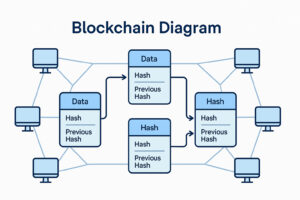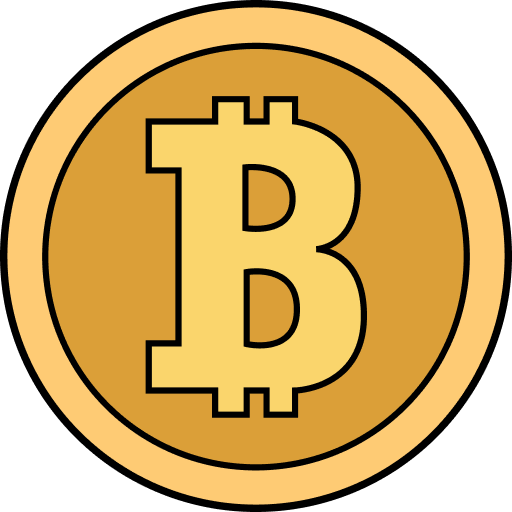A blockchain diagram is a graphic explanation of how blockchain technology functions at a fundamental level. With simple drawings, a blockchain diagram illustrates how information travels, how blocks are structured, how they are added, and how security is supported within the system. For those who want to learn about blockchain, a good blockchain diagram makes complicated concepts a lot simpler. Here, you will learn about a blockchain diagram, its relevance, and how it is applied in explaining various blockchain systems.

Illustration of how blocks and nodes connect in a typical blockchain system.
Learning the Fundamentals of a Blockchain Diagram
A blockchain diagram usually begins with the fundamental pieces: the individual blocks. Any block within the diagram is represented as a box or a rectangle, with information including transaction information, a timestamp, a hash, and the previous block’s hash. The boxes are set in a linear chain, representing how every block relates to the preceding block.
In a blockchain graphic, lines or arrows between blocks indicate the direction of information flow and the chronology of the transactions. An unbroken, tamper-proof ledger is this chain of blocks. Anyone is able to grasp the notion of immutability, or inability to change, by viewing the sequence.
Major Elements Shown in a Blockchain Diagram
Most blockchain models emphasize some central points:
- Blocks: These blocks contain transaction information, a unique identifier for the block, and a prior block’s hash.
- Hash Function: The image typically illustrates how the hash functions as a kind of fingerprint, linking every block to its prior one. That is the mechanism that secures the blockchain.
- Consensus System: Some illustrations depict nodes and how they arrive at consensus (e.g., Proof of Work or Proof of Stake). They often depict nodes as circles or computers that verify transactions prior to adding new blocks.
- Distributed Ledger: Blockchain diagrams typically show the way in which the ledger is distributed among several nodes, not in any single location.
These images make the blockchain’s technical aspects more accessible, particularly to new entrants.
How a Blockchain Diagram Makes Complicated Process Easier
It is simple to get lost in the jargon of blockchain, but a diagram clears everything up. Picturing it is easier when you try to explain it to a non-technical person. Verbal descriptions get only so far before the listener is switching off. A diagram, however, puts every process in steps, and you’re able to track it.
For instance, imagine a transaction being added to the blockchain. The process from initiating a transaction, through node validation, to a new block inclusion, and lastly to a network confirmation is illustrated in a diagram. This step-by-step breakdown converts a complicated subject into a straightforward flowchart and allows users to visualize everything that occurs in the background.
Types of Blockchain Diagrams
There isn’t just one way to visualize blockchain. Several types of diagrams serve different purposes:
- Straight Line Diagram: The traditional one, with blocks lined up in a row, every block pointing towards the next. It’s great for illustrating the basics.
- Network Topology Diagram: It displays several nodes in a network and how every node has a copy of the blockchain. It is helpful in comprehending decentralization and distributed ledgers.
- Consensus Flowchart: Here, we are looking at how nodes verify transactions and how consensus is achieved. Arrows indicate how nodes communicate while validating.
- Smart Contract Diagram: These are diagrams that include an additional layer, indicating how smart contracts are deployed and executed on the blockchain.
Every diagram is a mechanism to make a particular area of blockchain technology more comprehensible.
Advantages of a Blockchain Diagram
Why start with diagrams? The reason is straightforward: blockchain diagrams make it easier for people to learn faster and remember for longer.
- Clarity: Images simplify complex concepts into manageable chunks. Anyone who is not a blockchain expert can grasp the rudiments just by taking a glance at a picture.
- Communication: For blockchain project teams, diagrams are a common ground. All stakeholders, including developers, business analysts, and clients, are able to get on the same page faster.
- Troubleshooting: During debugging or while explaining errors, a diagram may be able to locate where in the process an error occurred.
- Education: Educators and trainers working on blockchain depend on diagrams to explain block structure, network operation, and security measures to students.
The advantages are apparent: diagrams make blockchain less scary and more accessible.
Building Blocks of a Blockchain Diagram
Let’s analyze the key elements you’ll see in most blockchain illustrations:
- Block Header: Contains metadata including the timestamp, version number, and Merkle root (summarizing all the transactions in the block).
- Block Body: Holds the list of transactions.
- Hash: A string that is generated by executing block information through a hash function. It is generally displayed as a small label beside every block.
- Previous Block Hash: Connects the current block to the previous block, giving rise to the chain.
- Nonces and Proof of Work: In illustrations of Bitcoin or comparable blockchains, you will find a ‘nonce’ field and a notation for how miners find a correct block.
By representing every element graphically, blockchain diagrams demystify the technology.
Real-Life Examples of Blockchain Diagrams
Let’s examine some examples of how blockchain diagrams are utilized:
- Bitcoin Blockchain Diagram: One of the most well-known examples, it illustrates how blocks are mined, how a new block points to the previous one, and how Proof of Work is used for consensus.
- Ethereum Block Diagram: Similar to Bitcoin, Ethereum block diagrams typically feature smart contracts and decentralized applications (dApps) and depict how code executes automatically on the blockchain.
- Permissioned vs. Public Blockchains Diagrams: Permissioned blockchain diagrams, for example, Hyperledger, include permissions and roles to make it simple to visualize how to control access.
In every situation, diagrams have the same goal: to make complex processes transparent at a glance.
How to Read and Understand a Blockchain Diagram
If you’re new to blockchain diagrams, here is how you should approach one:
- Begin with the blocks: Find the rectangles or boxes representing every block.
- Trace the arrows: These indicate the direction in which the information is flowing and the chronology of events.
- Identify hashes: Observe how every block’s hash links it to the one before, locking the chain in place.
- Identify nodes: Where they exist, nodes are participants in the network in the form of validators, miners, or just observers.
- Track the path of a transaction: Observe how a transaction travels from initiation through validation to confirmation.
By following these steps, one is able to comprehend even the most intricate blockchain diagram more easily.
Creating Useful Blockchain Diagrams
Developing a blockchain diagram is both an art and a science. A good diagram is simple yet comprehensive. Here are several tips for developing one:
- Make it concise: Avoid overwhelming the audience with too much information. Stick to the most important points and label only when necessary.
- Consistent symbols: Use, for instance, the same form for blocks and the same node icon throughout.
- Color-code various elements: It is simpler to distinguish between data or processes of different kinds.
- Add a legend: Provide an explanation, if symbols or abbreviations are utilized in your diagram.
Following these tips, you can draw a blockchain diagram that is more illuminating than confusing.
Applications of Blockchain Diagrams in Industry
Blockchain diagrams are not limited to books or training. They serve a purpose in the real world:
- Project Planning: Diagrams are utilized by the team to define system architecture prior to coding.
- Security Audits: Auditors examine diagrams to identify possible areas of vulnerability or weaknesses in the process.
- Investor Presentations: Both startups and more mature companies employ diagrams to present their technology to partners, regulators, or investors.
- Documentation: Any documentation package should include a straightforward diagram, which informs users and developers about how the blockchain works.
The ease of modification and simplicity in diagrams is a critical aspect of blockchain implementation and explanation.
Conclusion
A blockchain diagram is a highly effective tool for any individual looking to grasp the way blockchain functions. Simplifying complicated processes into plain, step-by-step illustrations, blockchain diagrams make the technology accessible to more people. Whether you are new to blockchain, a developer, or a business executive, gaining the knowledge to read and design blockchain diagrams enables you to explain concepts, troubleshoot, and design more effective systems. With blockchain technology developing further, the visualization of its processes will be an even more critical skill for education, collaboration, and innovation.












 Twitter
Twitter
 Telegram
Telegram
